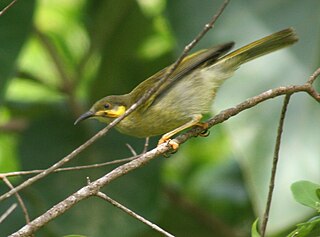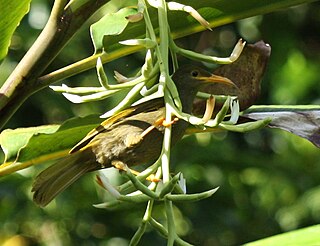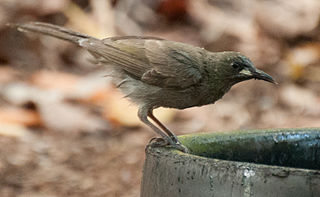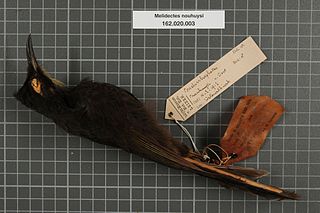
The banded honeyeater is a species of honeyeater in the family Meliphagidae with a characteristic narrow black band across its white underparts. It is endemic to tropical northern Australia.

The Polynesian wattled honeyeater or the eastern wattled honeyeater, is a species of bird in the honeyeater family Meliphagidae. It was considered conspecific with the Fiji wattled honeyeater and the kikau.

The green-backed honeyeater is a species of bird in the family Meliphagidae. It is monotypic within the genus Glycichaera. It is found in the Aru Islands, New Guinea and northern Cape York Peninsula. Its natural habitat is subtropical or tropical moist lowland forests.

The yellow-billed honeyeater, also known as yodeling giant honeyeater or chattering giant honeyeater, is a species of bird in the family Meliphagidae. It is endemic to Fiji.

The mangrove honeyeater is a species of bird in the honeyeater family Meliphagidae. The species was once considered to be conspecific with the varied honeyeater, but it is now treated as a separate species. These two species form a genus with the singing honeyeater.

The yellow-tinted honeyeater is a species of bird in the family Meliphagidae. It is found in northern Australia and Papua New Guinea. Its natural habitats are subtropical or tropical moist lowland forests and subtropical or tropical mangrove forests.

The yellow honeyeater is a species of bird in the family Meliphagidae. It is endemic to Australia.

The bridled honeyeater is a species of bird in the family Meliphagidae with distinctive rein-like markings on its face that is endemic to northeastern Queensland. It is found in subtropical or tropical moist upland forests and subtropical or tropical rainforests, usually above 300 meters. In winter, it descends to lower forests including mangroves, and can sometimes be seen in more open habitats.

The fuscous honeyeater is a species of bird in the family Meliphagidae. It is endemic to eastern Australia, where it inhabits subtropical and tropical dry forests.

The obscure honeyeater is a species of bird in the family Meliphagidae. It is found in New Guinea.

The white-gaped honeyeater is a species of bird in the family Meliphagidae. It is endemic to Australia.

The varied honeyeater is a species of bird in the family Meliphagidae. It is found in coastal areas of New Guinea and eastern Cape York Peninsula in Queensland, Australia. Its natural habitat is subtropical or tropical mangrove forests.

The sooty honeyeater is a species of bird in the family Meliphagidae. It is found in the New Guinea Highlands. Its natural habitat is subtropical or tropical moist montane forest.

The short-bearded honeyeater is a species of bird in the honeyeater family Meliphagidae. It is found mainly in West Papua. Its natural habitat is subtropical or tropical moist montane forests.
The long-bearded honeyeater, is a bird in the honeyeater family Meliphagidae.
Gilliard's honeyeater or the Bismarck honeyeater, is a bird species in the family Meliphagidae. It is the only species placed in the genus Vosea. It is endemic to New Britain. Its natural habitat is subtropical or tropical moist montane forests.

The sulphur-breasted myzomela, also known as the orange-breasted myzomela or orange-breasted honeyeater, is a species of bird in the family Meliphagidae.

Xanthotis is a genus of birds in the honeyeater family Meliphagidae.

The Fiji wattled honeyeater or northern wattled honeyeater, is a species of bird in the honeyeater family Meliphagidae. It was considered conspecific with the Polynesian wattled honeyeater and the kikau.

The kikau or western wattled honeyeater is a species of bird in the honeyeater family Meliphagidae. It was considered conspecific with the Fiji wattled honeyeater and the Polynesian wattled honeyeater.



















